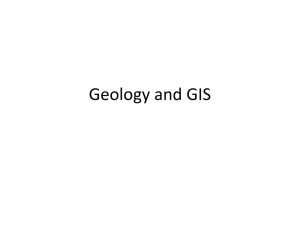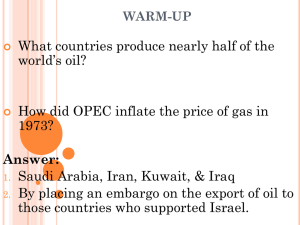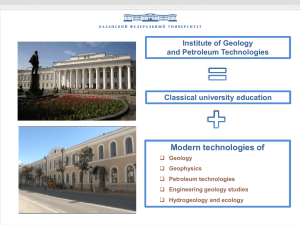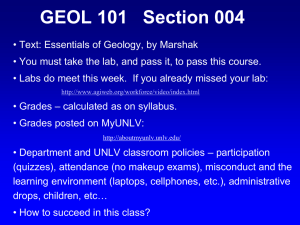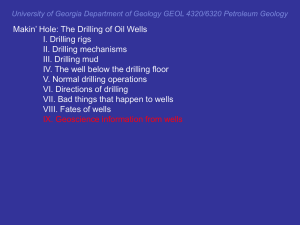4320Lxr12v01PetroleumSystem
advertisement
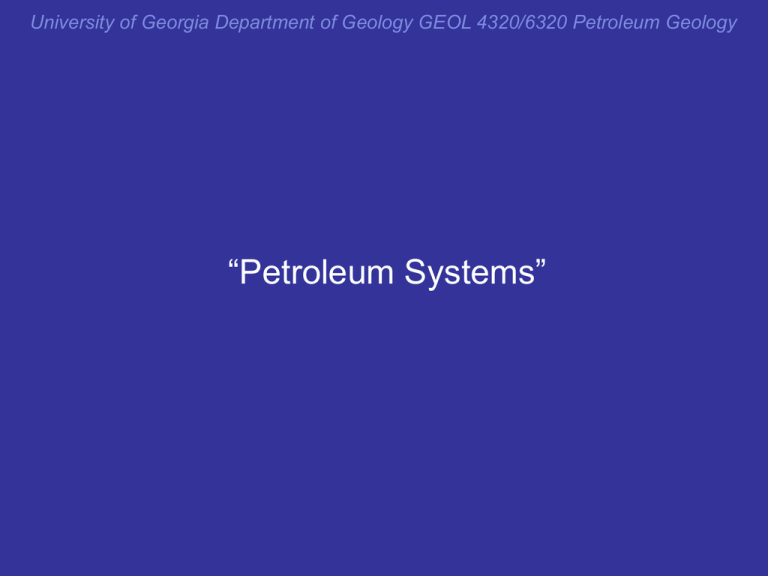
University of Georgia Department of Geology GEOL 4320/6320 Petroleum Geology “Petroleum Systems” University of Georgia Department of Geology GEOL 4320/6320 Petroleum Geology “Petroleum Systems” “Plate Tectonics” “Seqeunce Stratigraphy” “Integrative Petroleumology” University of Georgia Department of Geology GEOL 4320/6320 Petroleum Geology “Petroleum Systems” “Plate Tectonics” “Seqeunce Stratigraphy” “Integrative Petroleumology” PS insp University of Georgia Department of Geology GEOL 4320/6320 Petroleum Geology The “Petroleum System” and/or the “Hydrocarbon Machine” “Oil is found in the minds of men” or, more fully, “Where oil is first found is, in the final analysis, in the minds of men.” Wallace E. Pratt, Chief Geologist, Humble Oil Company; later Vice-President of Standard Oil Wallace E. Pratt PS insp University of Georgia Department of Geology GEOL 4320/6320 Petroleum Geology The “Petroleum System” and/or the “Hydrocarbon Machine” “Oil is found in the minds of men” or, more fully, “Where oil is first found is, in the final analysis, in the minds of men.” Wallace E. Pratt, Chief Geologist, Humble Oil Company; later Vice-President of Standard Oil Wallace E. Pratt PS insp University of Georgia Department of Geology GEOL 4320/6320 Petroleum Geology The “Petroleum System” and/or the “Hydrocarbon Machine” “Oil is found in the minds of men” or, more fully, “Where oil is first found is, in the final analysis, in the minds of men.” Wallace E. Pratt, Chief Geologist, Humble Oil Company; later Vice-President of Standard Oil Wallace E. Pratt PS insp University of Georgia Department of Geology GEOL 4320/6320 Petroleum Geology The “Petroleum System” and/or the “Hydrocarbon Machine” “Oil is found in the minds of men” or, more fully, “Where oil is first found is, in the final analysis, in the minds of men.” Wallace E. Pratt, Chief Geologist, Humble Oil Company Frequently cited by Michel T. Halbouty, past AAPG president and winner of AGI’s Legendary Geoscientist Award Wallace E. Pratt Michel T. Halbouty PS insp University of Georgia Department of Geology GEOL 4320/6320 Petroleum Geology The “Petroleum System” and/or the “Hydrocarbon Machine” “Oil is found in the minds of men” or, more fully, “Where oil is first found is, in the final analysis, in the minds of men.” UGA B.S. and M.S. Grads Michelle Anderson and Shawn Hall. PS insp University of Georgia Department of Geology GEOL 4320/6320 Petroleum Geology The “Petroleum System” and/or the “Hydrocarbon Machine” “Oil is found in the minds of men” or, more fully, “Where oil is first found is, in the final analysis, in the minds of men.” Wallace E. Pratt, Chief Geologist, Humble Oil Company Less poetically, Humans find petroleum most efficiently with a good model of how petroleum accumulations form. PS defns University of Georgia Department of Geology GEOL 4320/6320 Petroleum Geology The “Petroleum System” and/or the “Hydrocarbon Machine” A petroleum system: The integration in time and space of source, migration, reservoir, trap, and seal. LBR “. . . a petroleum province can be considered as the final result of an organized set of geologic events (in space and in time) that can be called a petroleum system. In such a system, the sequence of subsidence movements and associated flows is just as decisive as lithologic and geometric factors in the formation of a group of pools.” Perrodon & Masse 1984 The elements of a petroleum system consist of source rock, migration path, reservoir rock, seal, and trap, and those elements "must be placed in time and space such that a petroleum deposit can occur.” Magoon 1987 “All of the factors which affect the processes of hydrocarbon generation, migration, and accumulation constitute elements of a total system which may be described as a machine.” Meissner et al. 1984 Bibliography is on next page. PS defns University of Georgia Department of Geology GEOL 4320/6320 Petroleum Geology The “Petroleum System” and/or the “Hydrocarbon Machine” A petroleum system: The integration in time and space of source, migration, reservoir, trap, and seal. LBR “. . . a petroleum province can be considered as the final result of an organized set of geologic events (in space and in time) that can be called a petroleum system. In such a system, the sequence of subsidence movements and associated flows is just as decisive as lithologic and geometric factors in the formation of a group of pools.” Perrodon & Masse 1984 The elements of a petroleum system consist of source rock, migration path, reservoir rock, seal, and trap, and those elements "must be placed in time and space such that a petroleum deposit can occur.” Magoon 1987 “All of the factors which affect the processes of hydrocarbon generation, migration, and accumulation constitute elements of a total system which may be described as a machine.” Meissner et al. 1984 Bibliography is on next page. PS5 University of Georgia Department of Geology GEOL 4320/6320 Petroleum Geology A petroleum system: The integration in time and space of source, migration pathway(s), reservoir(s), trap(s), and seal(s). PS defns University of Georgia Department of Geology GEOL 4320/6320 Petroleum Geology The “Petroleum System” and/or the “Hydrocarbon Machine” A petroleum system: The integration in time and space of source, migration, reservoir, trap, and seal. LBR “. . . a petroleum province can be considered as the final result of an organized set of geologic events (in space and in time) that can be called a petroleum system. In such a system, the sequence of subsidence movements and associated flows is just as decisive as lithologic and geometric factors in the formation of a group of pools.” Perrodon & Masse 1984 The elements of a petroleum system consist of source rock, migration path, reservoir rock, seal, and trap, and those elements "must be placed in time and space such that a petroleum deposit can occur.” Magoon 1987 “All of the factors which affect the processes of hydrocarbon generation, migration, and accumulation constitute elements of a total system which may be described as a machine.” Meissner et al. 1984 Bibliography is on next page. PS defns University of Georgia Department of Geology GEOL 4320/6320 Petroleum Geology The “Petroleum System” and/or the “Hydrocarbon Machine” A petroleum system: The integration in time and space of source, migration, reservoir, trap, and seal. LBR “. . . a petroleum province can be considered as the final result of an organized set of geologic events (in space and in time) that can be called a petroleum system. In such a system, the sequence of subsidence movements and associated flows is just as decisive as lithologic and geometric factors in the formation of a group of pools.” Perrodon & Masse 1984 The elements of a petroleum system consist of source rock, migration path, reservoir rock, seal, and trap, and those elements "must be placed in time and space such that a petroleum deposit can occur.” Magoon 1987 “All of the factors which affect the processes of hydrocarbon generation, migration, and accumulation constitute elements of a total system which may be described as a machine.” Meissner et al. 1984 Bibliography is on next page. PS defns University of Georgia Department of Geology GEOL 4320/6320 Petroleum Geology The “Petroleum System” and/or the “Hydrocarbon Machine” A petroleum system: The integration in time and space of source, migration, reservoir, trap, and seal. LBR “. . . a petroleum province can be considered as the final result of an organized set of geologic events (in space and in time) that can be called a petroleum system. In such a system, the sequence of subsidence movements and associated flows is just as decisive as lithologic and geometric factors in the formation of a group of pools.” Perrodon & Masse 1984 The elements of a petroleum system consist of source rock, migration path, reservoir rock, seal, and trap, and those elements "must be placed in time and space such that a petroleum deposit can occur.” Magoon 1987 “All of the factors which affect the processes of hydrocarbon generation, migration, and accumulation constitute elements of a total system which may be described as a machine.” Meissner et al. 1984 Bibliography is on next page. PS refs University of Georgia Department of Geology GEOL 4320/6320 Petroleum Geology Perrodon, A., and P. Masse, 1984, Subsidence, sedimentation and petroleum systems: Journal of Petroleum Geology, v. 7, n. 1, p. 5-26. Magoon, L. B., 1987, The petroleum system—a classification scheme for research, resource assessment, and exploration (abs.): AAPG Bulletin, v. 71, n. 5, p. 587. Magoon, L. B., and W. G. Dow, 1994, The petroleum system, in Magoon, L. B, and W. G. Dow, eds., The petroleum system—from source to trap: AAPG Memoir 60, p. 3-24. Meissner, F. F., J. Woodward, and J. L. Clayton, 1984, Stratigraphic relationships and distribution of source rocks in the greater Rocky Mountain region, in J. Woodward, F. F. Meissner, and J. L. Clayton, eds., Hydrocarbon source rocks of the greater Rocky Mountain region: Denver, CO, Rocky Mountain Association of Geologists, p. 1-34. PS University of Georgia Department of Geology GEOL 4320/6320 Petroleum Geology The “Petroleum System” and/or the “Hydrocarbon Machine” 1. Deposition of organic-rich sediment 2. Burial of same to temperature for generation of petroleum 3. Availability at Time 2 of migration pathway for petroleum 4. Availability of reservoir, seal, and trap at or after Time 2. PS University of Georgia Department of Geology GEOL 4320/6320 Petroleum Geology A petroleum system: The integration in time and space of source, migration, reservoir, trap, and seal. LBR “. . . a petroleum province can be considered as the final result of an organized set of geologic events (in space and in time) that can be called a petroleum system. In such a system, the sequence of subsidence movements and associated flows is just as decisive as lithologic and geometric factors in the formation of a group of pools.” Perrodon & Masse 1984 Gussow University of Georgia Department of Geology GEOL 4320/6320 Petroleum Geology A petroleum system: The integration in time and space of source, migration, reservoir, trap(s), and seal. Gussow, W. C., 1954, Differential entrapment of oil and gas; a fundamental principle; American Association of Petroleum Geologists Bulletin, v. 39, p. 547-574, as reprised in the Oil and Gas Journal. University of Georgia Department of Geology GEOL 4320/6320 Petroleum Geology Critical moment: The critical moment is that point in time selected by the investigator that best depicts the generation-migration-accumulation of most hydrocarbons in a petroleum system. A map or cross section drawn at the critical moment best shows the geographic and stratigraphic extent of the system. Magoon, L.B., and W. G. Dow, 1994, The petroleum system, in Magoon, L. B, and W. G. Dow, eds., The Petroleum System—From Source to Trap: AAPG Memoir 60, p. 3-24. University of Georgia Department of Geology GEOL 4320/6320 Petroleum Geology Critical moment: The critical moment is that point in time selected by the investigator that best depicts the generation-migration-accumulation of most hydrocarbons in a petroleum system. A map or cross section drawn at the critical moment best shows the geographic and stratigraphic extent of the system. Magoon, L.B., and W. G. Dow, 1994, The petroleum system, in Magoon, L. B, and W. G. Dow, eds., The Petroleum System—From Source to Trap: AAPG Memoir 60, p. 3-24. The critical moment is the time of source-rock maturation and of migration of petroleum into its primary trap. LBR University of Georgia Department of Geology GEOL 4320/6320 Petroleum Geology Mag & Dow Ex University of Georgia Department of Geology GEOL 4320/6320 Petroleum Geology University of Georgia Department of Geology GEOL 4320/6320 Petroleum Geology University of Georgia Department of Geology GEOL 4320/6320 Petroleum Geology University of Georgia Department of Geology GEOL 4320/6320 Petroleum Geology PGSG PS University of Georgia Department of Geology GEOL 4320/6320 Petroleum Geology Arthur & Schlanger University of Georgia Department of Geology GEOL 4320/6320 Petroleum Geology University of Georgia Department of Geology GEOL 4320/6320 Petroleum Geology University of Georgia Department of Geology GEOL 4320/6320 Petroleum Geology University of Georgia Department of Geology GEOL 4320/6320 Petroleum Geology University of Georgia Department of Geology GEOL 4320/6320 Petroleum Geology University of Georgia Department of Geology GEOL 4320/6320 Petroleum Geology University of Georgia Department of Geology GEOL 4320/6320 Petroleum Geology University of Georgia Department of Geology GEOL 4320/6320 Petroleum Geology University of Georgia Department of Geology GEOL 4320/6320 Petroleum Geology University of Georgia Department of Geology GEOL 4320/6320 Petroleum Geology University of Georgia Department of Geology GEOL 4320/6320 Petroleum Geology Gluyas & Swarbrick 2004 University of Georgia Department of Geology GEOL 4320/6320 Petroleum Geology University of Georgia Department of Geology GEOL 4320/6320 Petroleum Geology University of Georgia Department of Geology GEOL 4320/6320 Petroleum Geology University of Georgia Department of Geology GEOL 4320/6320 Petroleum Geology University of Georgia Department of Geology GEOL 4320/6320 Petroleum Geology University of Georgia Department of Geology GEOL 4320/6320 Petroleum Geology University of Georgia Department of Geology GEOL 4320/6320 Petroleum Geology University of Georgia Department of Geology GEOL 4320/6320 Petroleum Geology University of Georgia Department of Geology GEOL 4320/6320 Petroleum Geology Selley p. 207 (uniform geothermal gradient) G&S page 75 & 77 Selley 1998 University of Georgia Department of Geology GEOL 4320/6320 Petroleum Geology University of Georgia Department of Geology GEOL 4320/6320 Petroleum Geology Gluyas & Swarbrick 2004 University of Georgia Department of Geology GEOL 4320/6320 Petroleum Geology University of Georgia Department of Geology GEOL 4320/6320 Petroleum Geology Thermal Cond University of Georgia Department of Geology GEOL 4320/6320 Petroleum Geology Thermal Cond University of Georgia Department of Geology GEOL 4320/6320 Petroleum Geology PGSG PS con PS ex University of Georgia Department of Geology GEOL 4320/6320 Petroleum Geology Reef & talus present vs. not present updip from source rocks; res & migrn path present or not (could be opposite side of mirror-image basin) one side with no subsidence and thus no maturation one side with no source rock. Thrusting moves reservoir over younger source rock in foot wall; potential source in hanging wall never matures. Simple source-migrn-res-seal system deposited but leaks updip to seap; fault and/or salt dome (that forms downdip from growth fault) provide traps. Deposition of source over half of sloping deposurface; folding, erosion, and deposition make unconformity trap, but only one side has source beneath. In sequential normal fault block system where source rock covered only half of basin, some blocks have no source rock, and some blocks have no fault seal. Non-vertical strike-slip fault moves anticlinal traps past lacustrine source rocks earliest gets no charge, later oil, and even later gas. Meandering channel sand is in stratum that is tilted and then faulted; fault provides migration path to meanders updip from fault but not down. University of Georgia Department of Geology GEOL 4320/6320 Petroleum Geology Sources North 1980 Asquith and Krygowski 2004 refs Rigzone Assaad 2008 Schlumberger Log Interpretation P&I AAPG Basic Well Log Analysis course notes Schlumberger Oilfielld Glossary Baker-Hughes Atlas of Log Responses Bjørlykke 2010 Selley 1978, Porosity gradients in North Sea oil-bearing sandstones: Jo. Geol. Soc. London v. 135, 119-132. Conaway 1999 Crain’s Petrophysical Handbook Selley 1998 Glover’s Petrophysique Shell Petroleum Handbook (1983) Gluyas & Swarbrick 2004 Shepherd 2009 Jonathan B. Martin UF class notes Tissot & Welte (1984) Wikipedia University of Georgia Department of Geology GEOL 4320/6320 Petroleum Geology White sans-serif Helvetica text Light gray Times New Roman text Light gray Times New Roman text 14 White sans-serif Helvetica text 14 Title Notes tools add-ins So what? Maximal Larger red text Gray lines Red text ? Lighter gray text U Darker gray text Black text Black text Darker gray text Orange text Blue text Wikipedia image LBR 1/2010 ? White text Tan text White text White text Blue text Faint blue text Big text with trans bkground Powerpoint blue
